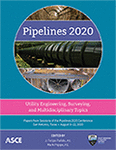Pipelines 2020
Consequences of Under-Estimating Friction Losses in Wastewater Forcemains
Publication: Pipelines 2020
ABSTRACT
An accurate estimation of energy losses caused by pipe friction is important for the analysis and design of forcemain systems. Friction losses in a forcemain are primarily dependent on the hydraulic roughness of the pipe; which is a function of the material, age, size, condition of the pipe, and characteristics of the wastewater. One of the most common approaches used to estimate the friction losses in a pipe is the Hazen Williams Equation, where the Hazen Williams roughness coefficient (C-Factor) is used to represent the roughness parameter and consequently friction losses. Therefore, appropriate selection of C-Factor is critical to hydraulic calculations of a pipeline, as it would impact pipe sizing and can have a significant impact on pump selection. As a best practice, most engineers consider a range of C-Factors in the hydraulic calculations, representing new and aged conditions of the pipe. Hydraulic analyses performed by the Author of more than 14 municipal wastewater forcemains located in the United States and other available literature determined that C-Factors from in-service forcemains are much lower than typical values used in practice. Approximately 60% of forcemain systems evaluated are operating at C factors less than 100. Results suggest that the wastewater slime layer affects forcemains in a similar manner regardless of pipe material. Nearly all lift station pumps evaluated were found to be operating to the left of the design point which increases operational costs due to longer pump run times at lower efficiency. In many cases the actual capacity of the lift station was found to be significantly less than the original design capacity. This paper will compare the actual C-Factors calculated from in-service forcemains to the C-Factors used in the original design and identify the increased energy consumption and operational costs resulting from underestimating friction losses (i.e., over-estimating C-Factors). In addition, the paper will provide recommendations to identify ranges of in-service C-Factor values and proper selection of C-Factors to be used for wastewater forcemain design.
Get full access to this article
View all available purchase options and get full access to this chapter.
REFERENCES
Bizier, P. (2007). Gravity sanitary sewer design and construction. ASCE.
Boon, A. G. (1995). Septicity in sewers: causes, consequences and containment. Water Science and Technology, 31(7), 237–253.
Dettmer, A., (2014) Force Main Condition Assessment: New Technologies & Case Studies, Water Environment Association of Texas, CMOM Workshop.
Escarameia, M., Lauchlan, C. S., Gahan, C., & Dabrowski, C. (2004). Experimental and numerical studies on movement of air in water pipelines.
Islander, R. L., Devinny, J. S., Mansfeld, F., Postyn, A., & Shih, H. (1991). Microbial ecology of crown corrosion in sewers. Journal of Environmental Engineering, 117(6), 751–770.
Kienow, K. (1989). Sulfide in Wastewater Collection and Treatment Systems. ASCE Manuals and Reports on Engineering Practice No. 69, ASCE, New York.
Larsen, T., Arensman, M., & Nerup-Jensen, O. (2015). Including Pressure Measurements in Supervision of Energy Efficiency of Wastewater Pump Systems. Journal of Hydraulic Engineering, 142(2), 04015048.
Michalos, C. T. (2016). Hydraulic effects of biofilms on the design and operation of wastewater forcemains (Doctoral dissertation, Colorado State University).
Papa, F., & Radulj, D. (2013). Canada takes a lead in benchmarking pump energy efficiency. Water 21, 30–33.
Pozos, O. E. (2007). Investigation on the effects of entrained air in pipelines. Germany: Universität Stuttgart. PhD Thesis http://elib.uni-stuttgart.de/opus/frontdoor.
Pozos-Estrada, O., Fuentes-Mariles, O. A., & Pozos-Estrada, A. (2012). Gas pockets in a wastewater rising main: a case study. Water Science and Technology, 66(10), 2265–2274.
Tchobanoglous, G., Franklin, L.B., & Stensel, H. D. (2003). Wastewater engineering: treatment and reuse. Edition 4th. Metcalf and Eddy Inc.
Thomson, J. C., Morrison, R. S., & Sangster, T. (2010). Inspection Guidelines for Wastewater Force Mains. Water Intelligence Online, 9, 9781843392866.
Zloczower, N. (2010). Reduction of damage and hindrance to wastewater transmission systems caused by air pockets by deployment of air valves. Pipelines 2010: Climbing New Peaks to Infrastructure Reliability: Renew, Rehab, and Reinvest (pp. 449–462). ASCE.
Information & Authors
Information
Published In
Pipelines 2020
Pages: 11 - 20
Editors: J. Felipe Pulido, OBG, Part of Ramboll and Mark Poppe, Brown and Caldwell
ISBN (Online): 978-0-7844-8321-3
Copyright
© 2020 American Society of Civil Engineers.
History
Published online: Aug 6, 2020
Published in print: Aug 6, 2020
Authors
Metrics & Citations
Metrics
Citations
Download citation
If you have the appropriate software installed, you can download article citation data to the citation manager of your choice. Simply select your manager software from the list below and click Download.
